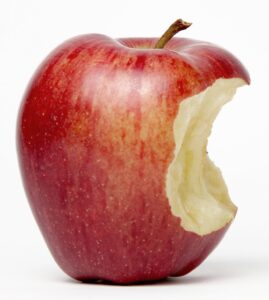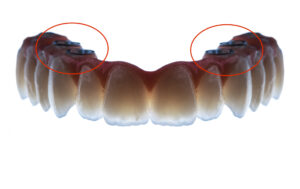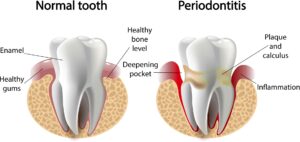Header logo
header top contact widget
Asheville dental specialist
Dental Implants Not ‘One Size Fits All’
Posted on Sep 21, 2021 by William J. Claiborne, DDS MS
A periodontist specializes in the diagnosis and placement of dental implants, in addition to the treatment of all stages of periodontal disease.
For people who are considering dental implants to replace teeth, this level of expertise provides greater reassurance of successful treatment outcomes. A periodontist can also offer patients with a wider choice of implant systems.
How can patients have more dental implant options through a periodontist?
When general dental offices offer dental implants, some general dentists offer implant selection and placement along with the restoration of the implant. (“Restoration” refers to the replacement crown that is attached to the implanted portion.)
Although generalists complete training in dental implants, most courses are offered by particular implant manufacturers. This means that the course focuses on the systems available through this one maker, which may or may not include the one most appropriate for your individual needs.
This is why most generalists refer the placement portion to a periodontal specialist. For their patient, this can mean a higher level of success, especially for complex needs.
For example, a patient who is missing a lot of bone mass (due to missing natural teeth for many years) benefits from the specialized skills of our Asheville periodontal office. A periodontist can incorporate bone rebuilding procedures into treatment to a proper depth. This specialist can help to restore bone that has occurred in the mandible (lower jaw) or maxilla (upper jaw), which may also require a sinus lift.
Another example is a patient who has lost teeth due to periodontal (gum) disease. Because a periodontist combines advanced skills in treating gum disease as well as in dental implants, these patients have an added advantage when it comes to treatment success.
For many reasons, dental implants have become the preferred tooth replacement option. There are over 40 different implant systems, each designed to accommodate various challenges and preferences. Some of the more common types include:
Traditional Dental Implants: In this process, dental implant treatments is done in a couple of stages. In the first stage, placement of each implant is performed. This involves small incisions in pre-selected placement points. In our Asheville periodontal dental office, these points are determined through computerized imaging, taking the guesswork out of the depth and angle of each implant placed. Once the implant is in proper position, the gum tissue is closed over the implant sites.

Several implants can often hold a full arch of teeth
The second stage involves a “healing period” of 3 – 6 months. During this phase, the bone grows around the implant(s) to secure each in place. The patient’s denture or partial denture can be comfortably worn during this time. This process is known as osseointegration, which describes the jaw bone growing around the implanted portion. This is what secures the implant so it provides stable, dependable biting and chewing strength.
After osseointegration is complete, the implant sites are uncovered and a post is positioned in the implant’s interior. Onto the posts, replacement teeth are attached. Once the final teeth are secured, patients can enjoy their confident smile along with the biting and chewing comfort like that of natural teeth.
Non-Removable Teeth Attached To Implants: In the past, the more affordable ‘full arch’ systems were typically those designed to support removable teeth. (An ‘arch’ is a full arrangement of all upper or all lower teeth.) However, some people feel removable teeth are too similar to the denture they wish to replace. Although firmly secured, the chore of having to remove teeth to clean them is a task many people want to eliminate.
A number of affordable implant systems are now available, designed to provide non-removable options that are more affordable. For example, the All On 4 dental implant system is made to support non-removable teeth on just 4 implants. With the implanted portions placed at unique angles, these longer implants can fully distribute biting and chewing forces. Another advantage of All On Four is their ability to be placed in minimal bone.
This is good news for people who are long-time denture wearers and were told they have too little bone to support implants. Or, they may have been advised to have bone grafts to rebuild the bone to an adequate height. This adds time and expense to implant treatment. Often, the All On 4 design is able to overcome this obstacle.
‘Same-Day’ Dental Implants: Advancements in dental implant systems and technology have evolved into implant placement and teeth attachment that can be accomplished in a single day. Some implant designs can position implants in the jaw bone in a way that they are able to support replacement teeth immediately.
With the replacement teeth created prior, the teeth may be attached without delay. In some cases, a previously-made denture or partial can be reconfigured to attach to newly placed implants. However, mounting replacement teeth to a just-placed implant isn’t wise for certain situations. This option should be diagnosed and performed by an experienced, skilled and highly-trained dental specialist in order to achieve a successful outcome. While “same-day” procedures can sound appealing, choose care where your individual needs are a priority.
Modern implant dentistry is successful, safe, dependable and can provide nearly immediate benefits. Our office enjoys a reputation for being on the cutting edge of implant dentistry’s techniques, technology and materials. This assures our patients of care that minimizes discomfort and treatment time while optimizing their final results.
Dental implants are designed to last a lifetime, making them an excellent investment. They are the closest thing to the natural teeth you once had, restoring the ability to bite, chew, speak and laugh confidently.
Over the years, I have been a witness to the transformations many implant patients undergo after treatment. They seem to smile and laugh more, become more social, and focus on their oral and overall health to a greater extent.
The type of dental implant best suited for you can be determined after an examination and review of x-rays (we use Cone-Beam digital imaging). Call 828-274-9440 to begin with a private, no obligation consultation to discuss your best options.
Please know that, if cost is a concern, payment plans can help you enjoy your beautifully restored smile while making easy monthly payments. Too, in many cases, an implant is not needed to replace each missing tooth. Often, when several teeth are missing in one area, one or two implants can support a “bridge” of several teeth. This curtails the treatment costs by reducing the number of implants needed.
If dental fear or anxiety is a concern, please mention this during our consultation. In our Asheville office, our entire team strives to provide a respectful, compassionate environment. We offer oral and I.V. sedation (twilight sleep) for nearly any procedure as well as a gentle touch at every visit.
Misconceptions Of Oral Health
Posted on Sep 14, 2021 by William J. Claiborne, DDS MS
As a periodontal dental specialist, I have advanced skills in the treatment of gum disease and dental implants. In my specialty, I see patients who have various issues related to oral health. Some of these can be resolved with minor treatment and others require more involved procedures.
In many cases, however, a factor in the severity of certain issues occur because it was assumed the problem would resolve itself. Some patients have also assumed that certain signs or symptoms were “normal”.
The health of the mouth is largely reliant on the condition of the gum tissues. This moist, soft covering of tissues is a protective blanket for the structures underneath. Gum tissues protect the structures that support natural teeth as well as their roots.
Yet, because the gums are not visible as are teeth, it is easy to “back burner” problems. Some of these problems DO resolve on their own. However, in too many cases, what is set aside eventually requires extensive treatment; treatment that may have easily been avoided with early care.
I’d like to address some of the more common issues I see that are misconceptions…
Assuming seeing blood in the sink when brushing teeth is normal: Srubbing teeth so rigorously that they bleed is not a sign of doing a good job. This action not only wears away precious tooth enamel, it wears away the gum tissues that wrap the base of teeth.
Gums that bleed when brushing are also a symptom of periodontal (gum) disease. In addition, gum disease can cause tenderness, swelling or frequent bad breath. Without treatment, gum disease will progress further. This is why it is the nation’s leading cause of adult tooth loss.
Protect tooth enamel and gum tissues by using a soft to medium bristled toothbrush and a non-abrasive toothpaste (never substances such as baking soda). Using a swirling motion (rather than going back-&-forth), avoid applying too much pressure. Make sure that the tips of the bristles are contacting the surfaces of teeth. Hint: If you notice your toothbrush’s bristles flay outward after a month or so of use, you’re pressing too hard.
Ignoring gum recession: The gums are designed to snugly wrap the base of each tooth, serving to seal out bacteria. Although the aging process and oral dryness can shrink gum tissues, a common cause of receded gums is gum disease.
Gum recession is what causes sensitivity to hot, cold or the bristles of a toothbrush. Oftentimes, a bite of ice cream can send a jolt of pain. Even without the sensitivity, recession can leave the darker tooth root areas exposed. This leaves the tooth vulnerable to damage by oral bacteria.
Ignoring frequent bad breath: Bad breath is typically a by-product of bacteria build up. Although certain medical conditions can contribute to bad breath, keeping oral bacteria levels under control will minimize the risk of having smelly breath odor.
Saliva is what controls a significant amount of oral bacteria. However, without regular brushing and flossing, bacteria can quickly exceed what saliva is able to manage.
This is why it is important to brush twice daily and floss daily. These small tasks help to control bacteria by removing the sticky buildup of plaque. If not removed, plaque hardens into what is known as tartar. Tartar is a destructive mass of bacteria that can no longer be brushed or flossed away.
Having gum depth measurements of four and over: During regular check-ups, hygienists check gum health by gently using a probe along the base of each tooth. This is done to indicate loosening of gum tissues on the front and back sides of teeth. A good check-up will have no depth measurement higher than a three.
If the depth measures a 4 or 5 (or higher), the gums are not sealing out oral bacteria sufficiently. This may be an indication of gum disease. The higher the number, the more advanced it is.
Assuming tooth loss is normal: Some people assume tooth loss is a natural part of the aging process. This is not accurate. Adults lose teeth due to accidents, decay or (most often) gum disease.
Occasionally, a tooth that needs crowning or filling is deemed a “problem” tooth. This causes some people to want the tooth removed rather than repaired. Yet, missing tooth roots in the jaw bone triggers a process of bone shrinkage. This is known as resorption.
Resorption occurs without the stimulating presence of the tooth root. As the bone declines in height and width, neighboring teeth can also be affected. Adjacent tooth roots in areas of insufficient bone structure are at a higher risk of cavities, gum disease, and tooth breaks or fractures. Statistics show that a tooth adjacent to a missing tooth is most likely the next to be lost.
When a tooth must be removed, we recommend replacing it with a dental implant. Because an implant is positioned in the bone, it helps halt bone loss and protect the well-being of neighboring teeth.
Not reacting to spots on the tongue, lips or inside the cheek: People occasionally develop canker sores inside the mouth. These can be caused by stress or having an acidic diet. Both should go away within ten days or so.
Any spot or change inside the mouth or throat that does not resolve on its own within two weeks should be seen immediately. This may be a sign of oral cancer and may appear as a red or white spot. Or, it may cause hoarseness or difficulty swallowing. If caught early, oral cancer can be successfully treated. Acting promptly is highly important as it can lead to disfiguring treatment and be even deadly.
Assuming oral health is contained in the mouth: It has been shown that having good oral health is an advantage to having good overall health. The potent bacteria of gum disease can enter the bloodstream and cause inflammatory reactions elsewhere in the body. Research has correlated a number of serious health problems with the infectious bacteria of gum disease. These include heart disease, stroke, some cancers, Alzheimer’s disease and arthritis.
As an Asheville periodontist, I believe that adults can improve their oral health by being informed patients and committed to having a healthy smile.
A good resource on maintaining good oral health is the web site of the American Academy of Periodontology: www.perio.org (go to Patient Resources). Or, call our Asheville periodontal dental office at 828-274-9440.
Be “Sweet” To Your Smile By Monitoring Sugar Intake
Posted on Aug 31, 2021 by William J. Claiborne, DDS MS
If Americans truly calculated the amount of sugar they’ve consumed at the end of each day, I believe most would be shocked. Even unintentionally, sugar intake can easily reach levels that are far beyond what is assumed.
For example, in a 2015 Washington Post article, it was reported that 25 percent of catsup is sugar. Alarmingly, one tablespoon has four grams of sugar, which is more sugar than a typical chocolate chip cookie.
The World Health Organization (WHO) recommends a maximum of no more than 10 teaspoons of free sugars per day. Regardless of age, the WHO advises keeping daily sugar consumption to less than 10 percent of calories “to reduce the risk of unhealthy weight gain and dental caries.”
However, our goal in limiting sugar is often sabotaged by hidden sugars.
Sugar comes in far more forms than just the white or brown bags of granular “cane sugar” we purchase in the grocery store. If you read the list of ingredients in foods and beverages, you may be surprised at how many forms of sugar are concealed with different names. At this time, there are more than sixty.
Here’s how to catch some of them:
Added sugar may be listed as syrup (examples are corn syrup or rice syrup) or anything with an ingredient that ends in “ose” (such as fructose, sucrose, maltose, dextrose). Other examples of added sugar include fruit nectars, juice concentrates, honey, agave and molasses.
Ideally, the WHO urges an intake of no more than 6 teaspoons (or less than 5 percent) of sugars per day to “provide additional health benefits.” This is an ambitious goal for Americans who have become literally addicted to sugar.
In a study of lab rats who were provided with a diet of food and intermittent supplies of sugar water, the results showed indications of addiction and symptoms of withdrawal. https://www.sciencedirect.com/science/article/abs/pii/S0149763407000589?via%3Dihub
The study spurned on a succession of additional studies. In one, it was noted that sugar “lights up” the same area of the brain as cocaine.
https://www.businessinsider.com/sugar-has-a-similar-effect-on-the-brain-as-cocaine-2016-4
As a periodontist, I’m especially concerned about sugar intake to the detriment of oral health. Sugar lowers the natural pH levels in saliva and triggers a process that is the beginning of tooth demineralization. Demineralization describes the process where the enamel and tooth structures are dissolved.
Although sugar is not a healthy food choice for any part of the body, it is important to remember that it is the mouth that is the entry point for what we eat or drink. Thus, the destructive nature of sugar begins by causing an imbalance in the mouth through altering the healthy formulation of saliva.
For a minute, think of the foods you consumed yesterday. Coffee with sweetened creamer? Toast with jam? Sweet tea with lunch? A candy bar and cola as a mid-afternoon snack? Catsup over your fries at dinner, followed by a bowl of ice-cream?
When we are conscious of just how much sugar is being consumed over the course of a day, it becomes easier to make better choices. As we taper down little by little, it actually helps us to “wean” off the dependency of sugar so it doesn’t feel like deprivation.
As an Asheville Periodontist, I see patients every day who have periodontal disease, cavities and missing teeth that can be attributed to diet, smoking and insufficient oral hygiene. Many face involved treatment decisions that can be costly and take months to accomplish.
Although we pride ourselves on providing our patients with a comfortab
le experience backed by advanced skills and technology, so much of our treatment can be prevented with easy proactive measures. Eating a healthy diet, keeping the mouth moist, brushing and flossing, and seeing a dentist regularly are all practical ways to keep a healthy, confident smile.
Yet, “we don’t know what we don’t know.” Because our population is largely unaware of the extent of sugars in many foods and beverages, it is easy to consume far more than is realized.
 Take charge of your oral health by reading food labels, meal planning that limits sugars, and being highly committed to your oral hygiene routine at home. A few tips for a healthy mouth between dental check-ups are:
Take charge of your oral health by reading food labels, meal planning that limits sugars, and being highly committed to your oral hygiene routine at home. A few tips for a healthy mouth between dental check-ups are:
• Brush twice a day (at least) for two minutes each time. Use a fluoride toothpaste with a soft to medium bristle toothbrush.
• Floss your teeth every day before your brush to dislodge food particles caught between teeth. If flossing is difficult for you, try one of the water flossers. These are affordable and as effective as manual flossing.
• Brush your tongue after your teeth to unroot embedded bacteria, especially reaching the back area of the tongue (where most bacteria are embedded).
• Use an oral rinse that replenishes moisture twice a day (or as directed). These are available at most drug stores.
• Chew sugarless gum, preferably a brand that contains Xylitol. Xylitol looks and tastes like sugar, yet has 40 percent fewer calories.
• Drink plenty of water throughout the day. Be aware that beverages such as most coffee, tea and colas contain caffeine are drying to the mouth. Many medications also have the side effect of oral dryness – another good reason to stay hydrated.
Also, be aware of the signs and symptoms of gum disease. Sore, tender, bleeding, swollen or red gums are all warning signs. With prompt measures, we can greatly minimize treatment needs to rid your mouth of this dangerous bacteria that has been associated with a number of serious health problems (including stroke and some cancers).
If you haven’t seen your general dentist on a regular basis, call 828-274-9440. Our Asheville periodontal office can help to restore your mouth to a healthy state with the most conservative, yet effective, treatment possible.
How The Contours of Your Gums Can Enhance Smile’s Appearance
Posted on Aug 10, 2021 by William J. Claiborne, DDS MS
I remember the home of a beloved Great Aunt, whom I visited often growing up. One of the things that made her home so “homey” were the displays of bric-a-brac. As a youngster, I didn’t term her arrangements of china tea sets and Hummel figurines as bric-a-brac (they were “knick knacks,” to me). However, I found myself being drawn to her displays on shelves, in curios, and on tables moreso as I grew older.
To me, what was impressive about these groupings was how balanced they were. The china tea pots were centered, surrounded by carefully spaced cups and saucers. Hummel children were in playful arrays to appear as a happenstance assembly of friends.
As a Periodontist, I am now far more appreciative of how my Aunt kept such proper balance to these displays. Everything seemed so coordinated, harmonized.
As a specialist in the treatment of all stages of periodontal (gum) disease and the placement of dental implants, I am also the expert when it comes to the contours of gum tissues surrounding teeth. The gums are important to the health of your teeth as well as the appearance of a smile.
When it comes to protecting teeth, think of the gum tissues as a protective blanket. The gums cover over the under-structures of the mouth’s interior (oral cavity). If you’ll look at the base of each tooth, you’ll see that the gum tissues snugly wrap the base of each tooth. This protective seal is what prevents bacterial penetration below the gum line.
When gum tissues loosen their grip around teeth, the leading cause is gum disease. Gum disease weakens oral tissues and causes them to become inflamed. As the gums loosen, bacteria is able to work their way into the structures that support natural teeth (including bone).
When bacteria reach this level of oral structures, ridding it involves a more involved procedure than what a mere dental cleaning can combat. As it progresses, the gums become spongy and pus pockets form. Teeth loosen and may need removal. Gum disease is the leading cause of adult tooth loss.
Yet, gum tissues not only serve as a protective element of your mouth. The appearance of a smile can be greatly affected by the shape and amount of gum tissues exposed when smiling.
Balance is an element of beauty, according to studies. We are drawn to it. According to Penn State’s “Science in Our World: Certainty and Controversy”,
“Studies show that symmetrical faces are preferred and more attractive to others than people who have asymmetrical faces. Similarly shaped eyes and eyebrows, sides of the nose mouth can all fall into the symmetrical category.”
They shared findings of one study, performed over the course of two decades, that had men and women rank the attractiveness of people in photos. The study revealed:
“Men and women both overwhelmingly chose the most symmetric face. This test was an observational study, so it was only as clear and truthful as the participants of the study were. There wouldn’t really be a way to make this sort of study an experimental test, so as far as attraction goes, studies must rely on the opinions of the participants. However, the majority of the participants chose the most symmetrical faces as the most attractive ones, so it is easily said that it is true, symmetry equals attractiveness.”
http://www.livescience.com/7023-rules-attraction-game-love.html
Although “beauty is in the eye of the beholder,” symmetry seems to be a component of what humans define as beautiful and what we’re drawn to (although inner beauty is an important factor in what keeps us connected to an individual).
When a smile shows too much or too little gum tissue bordering the tops of teeth, it moves the smile line out of balance. For example, in a “beautiful” smile, the arches of gum tissues visible in a full smile are at a similar level. The amount of gum arches are in a complimentary line to teeth, rather than an amount that draws the eye. Too much gum tissue showing is referred to as a “gummy smile.”
A gummy smile is not an unattractive feature. Having one does, however, alter the appearance of a smile based on balance. For example, a diastema is a wide space between the two front teeth. It is often a hereditary trait. Although it is not unattractive feature, the eye seems drawn to that one spot rather than seeing the smile, as a whole, as a complement to other facial features. The individual may have beautiful lips or eyes, but the gap between the teeth is what is noticed as being “off.”
Quite frankly, some people are perfectly comfortable with having a gummy smile or a diastema. For them, it’s part of their personality or signature look. After all, what would Lauren Hutton, the famous model of the 70’s, have been without her diastema?
For other people, these features cause shyness, insecurity or a feeling of awkwardness. Some people try to smile with lips only. Others try to conceal a full smile with a hand. “Holding back” on a smile is a shame, especially since smiling is a proven asset to our frame of mind.
The act of smiling causes the brain to release chemicals known as endorphins. These trigger somewhat of a natural high, creating a happier mood. This has been shown to be true even when faking a smile.
Additionally, people who smile often are deemed happier, more confident and even younger. In smiling, the facial muscles pull upward and smooth out the skin to give the face a bit of a lift. Free of charge!
Another distortion in a balanced smile can be an uneven line of gum tissues, where there is more gum showing on some teeth than others. This up-and-down line of gum tissues creates a jumbled look. Again, the appeal of balance is disrupted.
In these cases, a “crown lengthening“ procedure is often advised. This is a simple procedure that alters the height of the gum tissues prior to placement of a crown (‘cap’). Not only does this provide a more flattering smile line, it protects the teeth involved while enhancing the tooth’s shape.
Another issue that impacts both appearance and the health of a tooth is gum recession. When the gums recede from the base of teeth, more sensitive and vulnerable areas of the tooth’s root are exposed. Exposure can lead to sensitivity and higher risk for bacterial penetration.
The procedure for most gum recontouring is known as a Gingivectomy. In this, our Asheville Periodontal dental office uses a dental laser. Gingivectomy is the most common procedure performed with a laser, which is used to precisely contour gingiva (gum tissue) for restorative, cosmetic, and periodontal needs.
The laser promotes rapid healing and reduces discomfort post-operatively with periodontal packing or sutures rarely needed. In the hands of a skilled periodontal specialist, laser technology also minimizes penetration depths. For minor procedures, lasers can sometimes require little or no anesthetic.
For more involved gum contouring, our Asheville periodontal office offers both oral and I.V. sedation. Oral sedation is a pill that helps patients relax. It also has an amnesiac effect, leaving most with little or no memory of treatment afterward.
I.V. sedation places the patient in a deeper sleep state, also erasing memory of the procedure. It is administered by a doctor of anesthesiology for optimal comfort and safety. In our office, this is overseen by Dr. Brad Stone, a Medical Doctor (MD) who is a board certified Anesthesiologist & Pediatric Anesthesiologist.
With both sedation options, patients are closely monitored with advanced safety equipment throughout treatment.
The health and appearance of your smile are important. It is proven that good oral health is a supportive component to your overall health. It is also shown that the appearance of a smile can add positively to an individual’s perception of “self”.
If you’re interested in improvements in the health and appearance of your smile, let’s discuss the possibilities during a consultation appointment. Call 828-274-9440. A referral is not always needed.
Recent Posts
Categories
Archives
- September 2024
- August 2024
- July 2024
- June 2024
- May 2024
- April 2024
- March 2024
- February 2024
- January 2024
- December 2023
- November 2023
- October 2023
- September 2023
- August 2023
- July 2023
- June 2023
- May 2023
- April 2023
- March 2023
- February 2023
- January 2023
- December 2022
- November 2022
- October 2022
- September 2022
- August 2022
- July 2022
- June 2022
- May 2022
- April 2022
- March 2022
- February 2022
- January 2022
- December 2021
- November 2021
- October 2021
- September 2021
- August 2021
- July 2021
- June 2021
- May 2021
- April 2021
- March 2021
- February 2021
- January 2021
- December 2020
- November 2020
- October 2020
- September 2020
- August 2020
- July 2020
- June 2020
- May 2020
- April 2020
- March 2020
- February 2020
- January 2020
- December 2019
- November 2019
- October 2019
- September 2019
- August 2019
- July 2019
- June 2019
- May 2019
- April 2019
- March 2019
- February 2019
- January 2019
- December 2018
- November 2018
- October 2018
- September 2018
- August 2018
- July 2018
- June 2018
- May 2018
- April 2018
- March 2018
- February 2018
- January 2018
- December 2017
- November 2017
- October 2017
- September 2017
- August 2017
- July 2017
- June 2017
- May 2017
- April 2017
- March 2017
- February 2017
- January 2017
- December 2016
- November 2016
- October 2016
- September 2016
- August 2016
- July 2016
- June 2016
- May 2016
- April 2016
- March 2016
- February 2016
- January 2016
- December 2015
- November 2015
- October 2015
- September 2015
- August 2015
- July 2015
- June 2015
- May 2015
- April 2015
- March 2015
- February 2015
- January 2015
- December 2014
- November 2014
- October 2014
- September 2014
- August 2014
- July 2014
- June 2014
- May 2014
- April 2014
- March 2014
- February 2014
- January 2014
- December 2013
- November 2013
- October 2013
- September 2013
- August 2013
- July 2013
- June 2013
- May 2013
- April 2013
- March 2013
- February 2013
- January 2013
- December 2012
- November 2012
- October 2012
- September 2012
- August 2012
- July 2012
- June 2012


